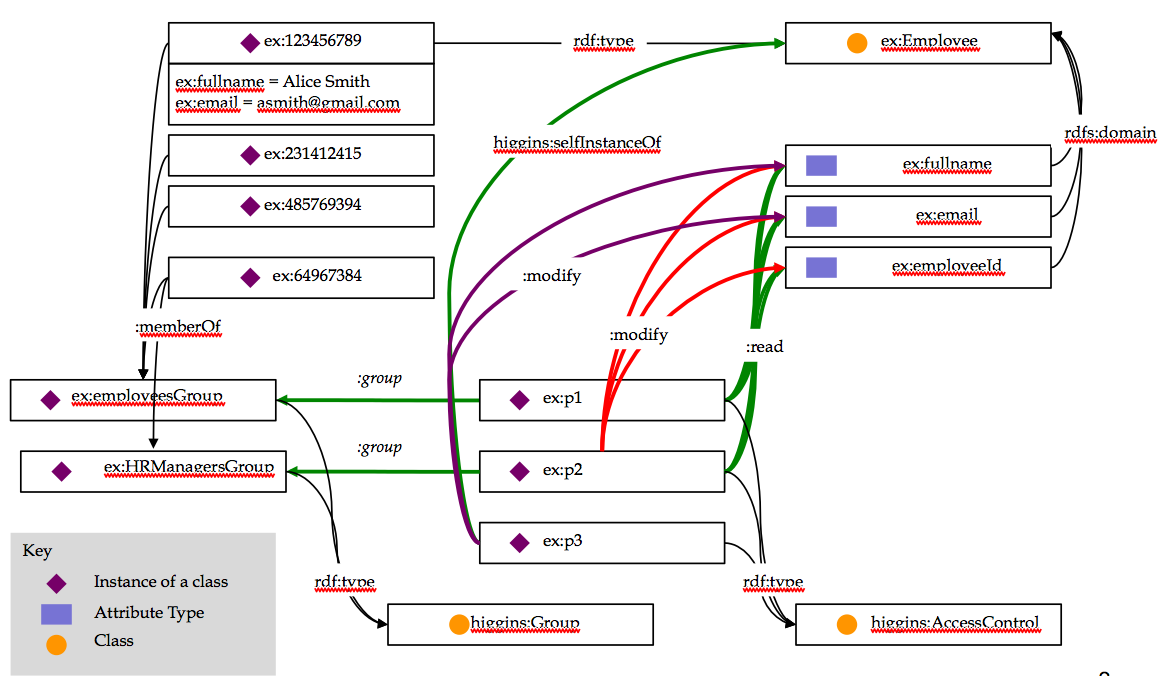Notice: This Wiki is now read only and edits are no longer possible. Please see: https://gitlab.eclipse.org/eclipsefdn/helpdesk/-/wikis/Wiki-shutdown-plan for the plan.
Difference between revisions of "HR Directory Access Control Policy"
(→Notes) |
|||
| Line 2: | Line 2: | ||
[[Image:Higgins_logo_76Wx100H.jpg|right]] | [[Image:Higgins_logo_76Wx100H.jpg|right]] | ||
| − | [[Image: | + | [[Image:Access-control-use-cases-hr-v2.png]] |
| − | + | ||
| − | + | ||
== Notes == | == Notes == | ||
| − | + | The above is a second (v2) attempt at modeling this use-case. | |
| + | * A new diagramming style is used--it is more compact at representing the literal attributes of an Entity within a single rectangular box. | ||
| + | * The entire use case now fits on one diagram (just barely!) | ||
| + | * The new "group" higgins:subject sub-attribute is now being used | ||
| + | * See [[HOWL Update 1.1.104]] for related changes to support this use case | ||
| − | + | The problem found last week remains. First some background: | |
| − | # what Attribute type(s) the Policy is talking about | + | * It seems clear that these two dimensions of "resource scoping" should be orthogonal: |
| − | # the set of Entities that the Policy is talking about | + | *# what Attribute type(s) the Policy is talking about |
| − | Either one or the other but not both of the above is optional. But the | + | *# the set of Entities that the Policy is talking about |
| + | *Either one or the other but not both of the above is optional. | ||
| + | The problem is that ex:p[1-3] all "point" to an Attribute. But in fact the Attribute type AND the Entity Class must be specified (otherwise the policy will apply to ANY instance of any class that has this Attribute type). | ||
==See Also== | ==See Also== | ||
* [[Access Control Use Cases]] - back to use cases | * [[Access Control Use Cases]] - back to use cases | ||
Revision as of 17:43, 13 July 2008
{{#eclipseproject:technology.higgins}}
Notes
The above is a second (v2) attempt at modeling this use-case.
- A new diagramming style is used--it is more compact at representing the literal attributes of an Entity within a single rectangular box.
- The entire use case now fits on one diagram (just barely!)
- The new "group" higgins:subject sub-attribute is now being used
- See HOWL Update 1.1.104 for related changes to support this use case
The problem found last week remains. First some background:
- It seems clear that these two dimensions of "resource scoping" should be orthogonal:
- what Attribute type(s) the Policy is talking about
- the set of Entities that the Policy is talking about
- Either one or the other but not both of the above is optional.
The problem is that ex:p[1-3] all "point" to an Attribute. But in fact the Attribute type AND the Entity Class must be specified (otherwise the policy will apply to ANY instance of any class that has this Attribute type).
See Also
- Access Control Use Cases - back to use cases


